#and Michelangelo's david is from 1501
Explore tagged Tumblr posts
Text
I'd say the funniest part Abt being a TMNT fan for me specifically is that I'm also an art restoration student. So everyday i go to class and learn crazy shit abt Donatello, Michelangelo, Raphael and Leonardo (as in. The artists) and then go home and learn crazy shit about Donatello, Michelangelo, Raphael and Leonardo (The ninja turtles) and I just have to live with that.
#tmnt#rotmnt#lottie talks#I'd say the funniest data is that Donatello (artist) is like. 100 years older than the other three#while Leonardo Michelangelo and Raphael are from the high renaissance#Donatello is from the start#like...#Donatello's david is from 1430 more and less#and Michelangelo's david is from 1501#as another fun fact#artist Michelangelo really admired Donatello#bc Michelangelo considered sculpture to be the finest version of art#and Donatello is considered to be the pillar of renaissance era sculpting#ALSO its said that Michelangelo had awful temper#and fucking hated leonardo and raphael bc they were sort of rivals#as another fun fact leonardo stole corpses from graveyards and dissected them bc he wanted to study anatomy#ALSO he was kicked out from where he lived at first (i think it was Florence but im not sure) bc someone accused him of being gay#anyways. when will we have a tmnt au where donnie is an old man and the rest are young and literally the same age and no one questions it#that said itd be rlly fun of someone did a version of splinter who was ACTUALLY into art history#i know 2012 said he wanted to be an artist as a kid bitbwe never rlly see that explored#give me a splinter who paints or give me death!
101 notes
·
View notes
Text

Michelangelo's Statue of David, created between 1501 and 1504, is known for its remarkable details, particularly in the right hand.
This iconic statue was carved from a single 6-ton slab of marble that had been discarded by two other sculptors due to flaws. The marble lay exposed to the elements for 26 years before a 26-year-old Michelangelo was awarded the contract.
Blog https://artifactsmuseumhistory.blogspot.com/?m=1
425 notes
·
View notes
Text

Michelangelo’s ‘David’ Was Carved Out of a Flawed Marble Slab
Two sculptors had tried and failed to chisel something out of the block—until Michelangelo stepped up.
Michelangelo’s David was recognized as a masterpiece the moment it was unveiled. In fact, its commissioners found the sculpture so beautiful, and so massive, that they decided its intended home, high up in the roof of a cathedral, just wouldn’t cut it.
The statue was conceived almost a century before Michelangelo picked up a chisel to create it. In the early 1400s, the Opera del Duomo, the workshop of Florence’s cathedral, began commissioning pieces for a series of 12 massive sculptures depicting prophets from the Old Testament. These would each be housed in niches of the church’s tribune, semi-domed apses in the roofline, over 260 feet high.
In 1464, Agostino di Duccio, a sculptor inexperienced with projects at such a large scale, was commissioned to create the statue. Duccio traveled to a Carrara marble quarry in Tuscany, where he handpicked a giant block of stone. Upon its arrival in Florence after a long, arduous journey, the block was found to be a flop. The hewed hunk of marble was tall but thin and riddled with holes and veins, imperfections both unaesthetic and potentially compromising to the structure of so large a statue.
Realizing his error, Duccio chipped at the stone with his hammers and chisels for a while, but soon gave up on his work. The abandoned wedge of marble went untouched for a decade until another sculptor, Antonio Rossellino, seized the mantle. After some attempts to salvage the work, he, too, deemed the block unusable. It was left naked in the Opera’s courtyard for another 25 years.
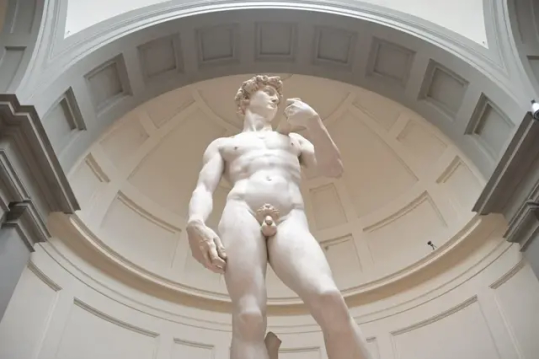
Finally, in the summer of 1501, the workshop’s overseers assigned the work to Michelangelo. In just over two years, he transformed the misunderstood marble block into the 17-foot-tall statue that is today one of the most famous artworks in history. At the unveiling, the unexpected size, weight, and beauty of the statue demanded a reshuffling of plans. In 1504, 30 Florentine cultural leaders, including Leonardo da Vinci and Sandro Botticelli, convened to determine David’s fate.
After months of raging debate, it was decided that the statue deserved a spot in the Piazza della Signoria, in front of Florence’s town hall. It took 40 men four days to transport a rope-bound David, caged in wooden scaffolding, from Michelangelo’s workshop to the plaza a half-mile away. Upon arrival, the artist took his chisel to his creation one last time, applying finishing touches. The statue had been designed for viewing from far below; this unexpected setting and perspective required slight modifications.
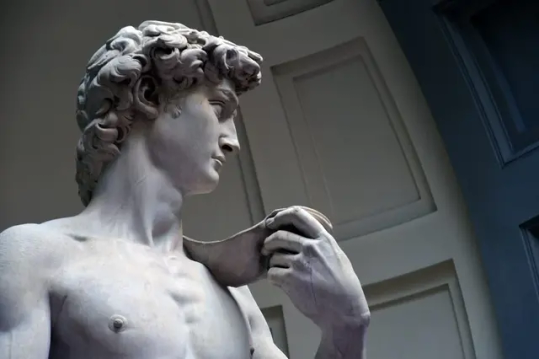
The statue became quickly known as “the Giant,” a symbol of liberty for the Florentine people, with his glare pointed at their rival city, Rome. Though beloved, the Giant fell victim to vandalism in his first year, when protestors pelted the colossal sculpture with stones. In 1527, a riot against the ruling class broke out in the plaza, and a bench thrown out of a window struck the statue, breaking its arm into three pieces. David went on to survive earthquakes and lightning strikes before the city council decided to protect him.
After almost 370 years, fans and art connoisseurs finally compelled the city to move David into the Galleria dell’Accademia for his protection in 1873; he still stands there today. Even in the confines of the museum, though, David was unsafe. In 1991, a mentally disturbed Italian artist, Pierro Cannata, snuck a hammer into the museum. With it, he lunged at David’s left foot, shattering a toe before being subdued by museum-goers. Cannata claimed that La Bella Nani, a figure from a Veronese painting, compelled him to strike David. Thanks to the attack, David’s beauty is now shielded from jealous hands and hammers by a wall of plexiglass.
By Adnan Qiblawi.
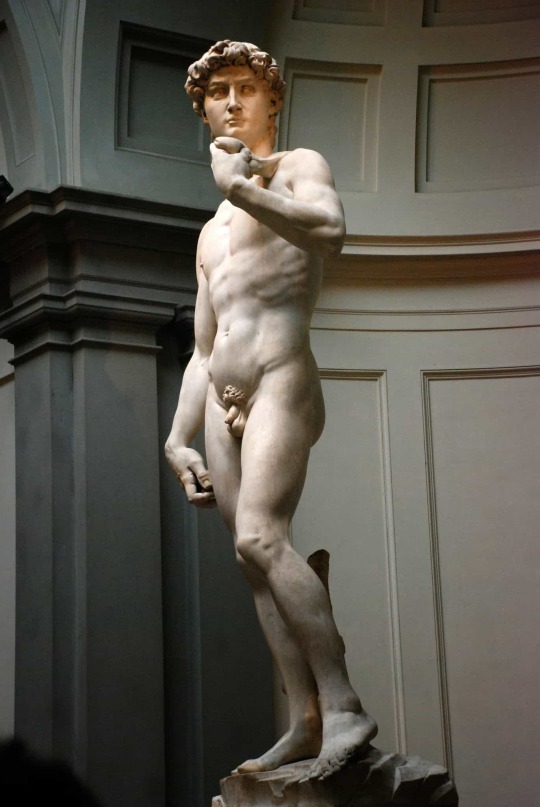
#Michelangelo#Michelangelo’s ‘David’ Was Carved Out of a Flawed Marble Slab#marble#marble sculpture#ancient artifacts#italian artist#sculptor#art#artist#art work#art world#art news
44 notes
·
View notes
Text



dream self portrait (2023) // details from david by michelangelo (1501-1504)
#dteam as art#also ive always been so obsessed with his cunty little pose#like okay work !#he slayed in more ways than one
316 notes
·
View notes
Text
Jilian Kirby, Jack Kirby's granddaughter, posted this writing by Neil Kirby (father/son respectively) in which he responds to the new Stan Lee documentary currently available to view on Disney+:
"The 13th century Islamic poet/scholar Rumi said, "The Ego is a veil between humans and God." In the Disney+ documentary bio of Stan Lee, the veil is lifted. Presented in the first person with Lee's voice providing a running narrative, it is Stan Lee's greatest tribute to himself. The literary expression of ego is the personal pronoun "I." Any decent English or Journalism teacher would admonish their students not to overuse it. So, the challenge is extended to anyone who wishes to count the number of "I's" during the 86-minute running time of Stan Lee.
I (oooops!) understand that, as a "documentary about Stan Lee," most of the narrative is in his voice, literally and figuratively. It's not any big secret that there has always been controversy over the parts that were played in the creation and success of Marvel's characters. Stan Lee had the fortunate circumstance to have access to the corporate megaphone and media, and he used these to create his own mythos as to the creation of the Marvel character pantheon. He made himself the voice of Marvel. So, for several decades he was the "only" man standing, and blessed with a long life, the last man standing (my father died in 1994). It should also be noted and is generally accepted that Stan Lee had a limited knowledge of history, mythology, or science. On the other hand, my father's knowledge of these subjects, to which I and many others can personally attest, was extensive, was extensive. Einstein summed it up better; "More the knowledge, lesser the ego. Lesser the knowledge, more the ego."
If you were to look at a list and timeline of Marvel's characters from 1960 through 1966, the period in which the vast majority of Marvel's major characters were created during Lee's tenure, you will see Lee's named as a co-creator on every character, with the exception of the Silver Surfer, solely created by my father. Are we to assume Lee had a hand in creating every Marvel character? Are we to assume that it was never the other co-creator that walked into Lee's office and said, "Stan, I have a great idea for a character!" According to Lee, it was always his idea. Lee spends a fair amount of time talking about how and why he created the Fantastic Four, with only one fleeting reference to my father. Indeed, most comics historians recognize that my father based the Fantastic Four on a 1957 comic he created for DC, "Challengers of the Unknown," even naming Ben Grimm (The Thing) after his father Benjamin, and Sue Storm after my older sister Susan.
Through the conflict between Lee and my father concerning creator credit gets glanced over with little mention, there is more attention paid to the strife between Lee and Steve Ditko, with Lee's voice proclaiming, "it was my idea*, therefore I created the character," Spiderman [sic]. In 1501, the Opera del Duomo commissioned a 26-year-old Michelangelo to sculpt a statue of David for the Cathedral of Florence - their idea, their money. The statue is called Michelangelo's David - his genius, his vision, his creativity.
I was very fortunate. My father worked at home in his Long Island basement studio we referred to as "The Dungeon," usually 14 - 16 hours a day, seven days a week. Most of the artists, writers, inkers, etc. worked at home, not in the Marvel offices as depicted in the program. Through middle and high school, I was able to stand at my father's left shoulder, peer through a cloud of cigar smoke, and witness the Marvel Universe being created. I am by no means a comics historian, but there are few, if any, that have personally seen or experienced what I have, and know the truth with first-hand knowledge.
My father retired from comic books in the early 1980's, and of course passed away in 1994. Lee had over 35 years of uncontested publicity, much, naturally, with the backing and blessing of Marvel as he boosted the Marvel brand as a side effect of boosting himself. The decades of Lee's self-promotion culminated with his cameo appearances in over 35 Marvel films starting with "X-Men" in 2000, thus cementing his status as the creator of all things Marvel to an otherwise unknowing movie audience of millions, unfamiliar with the true history of Marvel comics. My father's first screen credit didn't appear until the closing crawl at the end of the film adaptation of Iron Man in 2008**, after Stan Lee, Don Heck, and Larry Lieber. The battle for creator's rights has been around since the first inscribed Babylonian tablet. It's way past time to at least get this one chapter of literary/art history right. 'Nuff said.
Comparison of the origins for The Challengers of The Unknown and The Fantastic Four, both involving the teams coming together in an altruistic fashion after a near death experience in a plane/ship crash, as presented in Showcase #6 (1957) and The Fantastic Four #1 (1961) respectively:
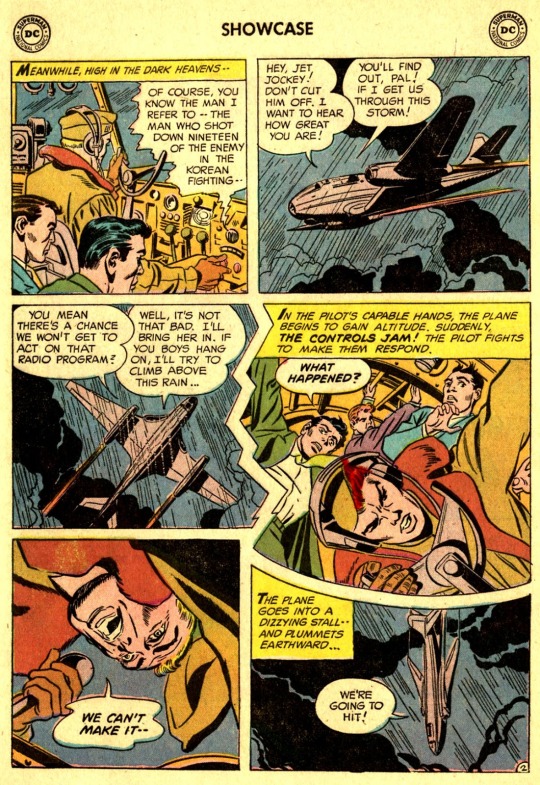
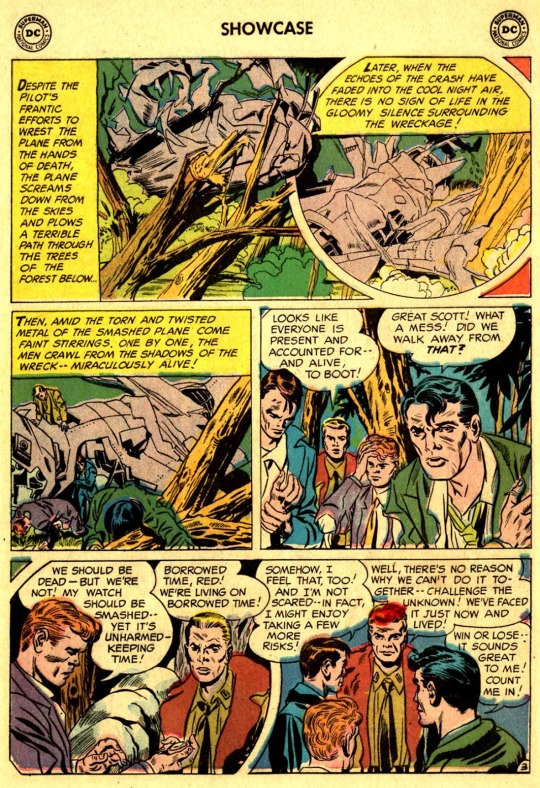
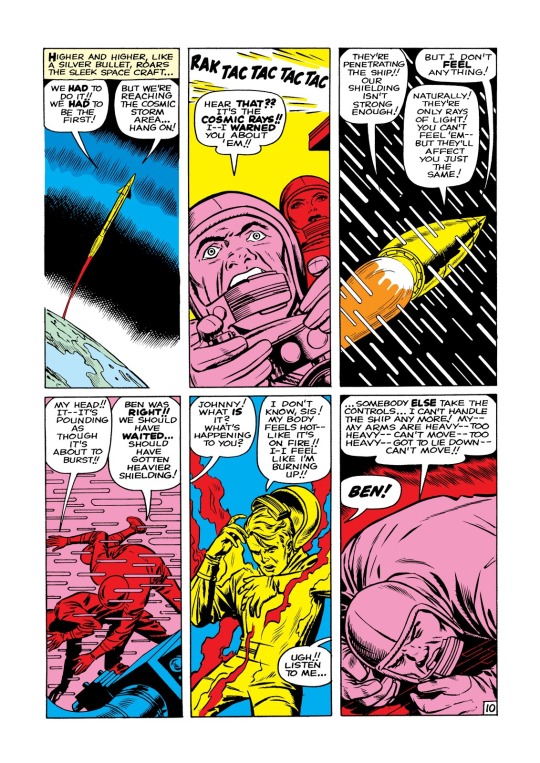

*Spider-Man is a Jack Kirby concept that originated between Joe Simon and C.C. Beck named "Silver Spider." Ditko has commonly stated that it bared too much similarity to The Fly, a character Kirby previously worked on at Archie, hence the change of hands on the project to Ditko. So far the presentation page and six page story Kirby did have been hidden by Marvel, with this Ditko drawing being our closest approximate:

**Kirby is credited in X-Men (2000) under "The Producers wish to thank the following for their assistance:"
212 notes
·
View notes
Text


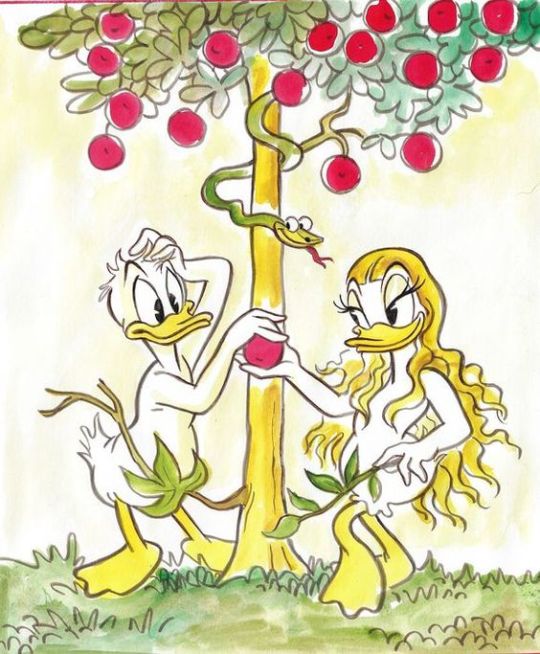
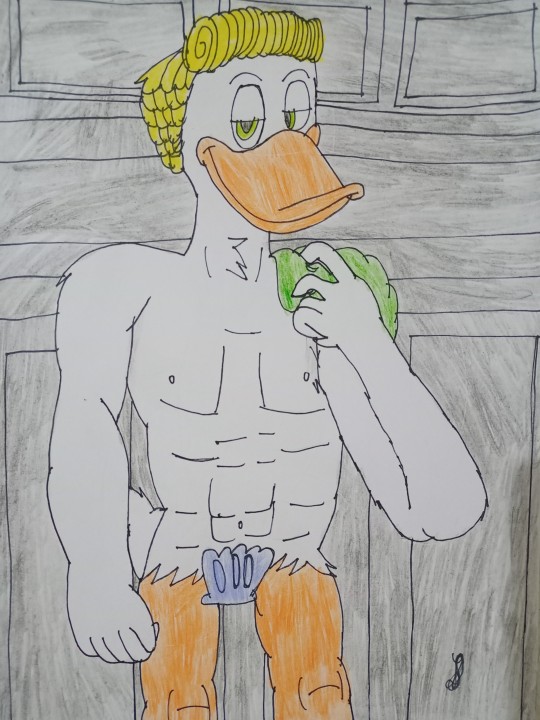
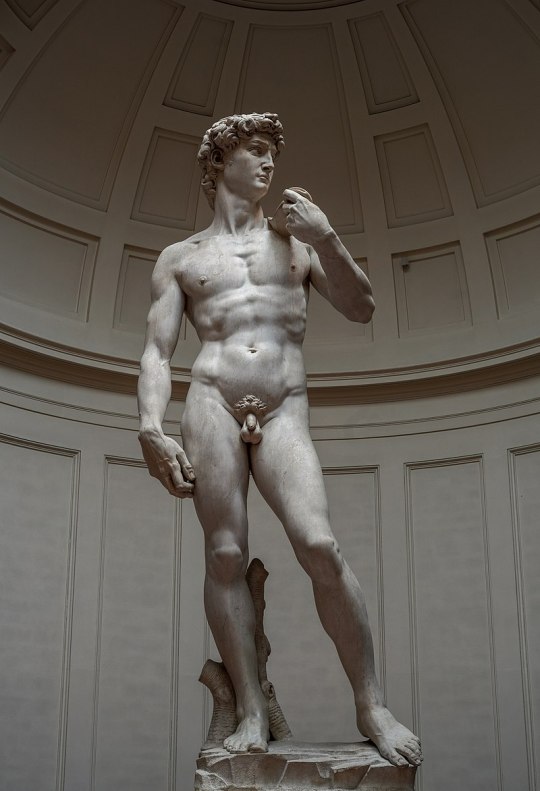
Duckvember - Human, Loved and Nude Duck (Ducks) - Donald and Daisy as Adam and Eve and Gladstone Gander as Michelangelo's David
No more old Ducklooney. XD Joking aside, I've always had a love for history and good old art, so I drew on these leftover themes from Duckvember as redraws from famous works.
The first drawing represents Donald and Daisy Duck as Adam and Eve, as the first humans, that is, as the first ducks. According to the Book of Genesis from the Bible, Adam and Eve lived in Paradise, that is, in the Garden of Eden, until they took the fruit from the tree of knowledge and were then forced to leave Paradise. Yes, they obeyed the Serpent, or Lucifer, who prompted them to commit the first sin and disobedience to God. Whether the red fruit is an apple or a pomegranate or something else, it is not known, but I certainly drew it as a red fruit that represents the fruit of knowledge, as I also drew the background of Eden, and represented the snake as Evronian (an enemy alien duck from the Paperinik New Adventures comics) , since they are certainly evil. Yes, I also drew as a redraw from the genius artwork painted by Tony Fernandez, one of the genius artists for Donald Duck comics. Poor Donald and Daisy, what have they gotten themselves into.
Another drawing presents Gladstone Gander as the Human Duck, in the pose of Michelangelo's David. David was a Biblical figure and king of Israel who reigned in the late 11th and early 10th centuries BC and was the writer of Psalms, Biblical songs. Michelangelo Buonarroti, who was an excellent Renaissance artist in the late 15th and early 16th century AD, created a statue of David from 1501 to 1504 and that statue represented the power of the Medici family. I always imagined a sexy Gladstone so I drew him as Michelangelo's David standing in Florence as a future statue pose. Although I have not managed to draw a fully human duck, although Gladstone is half goose, it is still strange to me that even though ducks look more humanoid, they have fully human legs. Anyway, this is my first time doing this, so I apologize for that. Yes, I put a shell, because I don't like to show indecent body parts, and it should be censored for children.
This is a joke after all. I hope you like these drawings and these ideas and surprises like this. Feel free to like and reblog this. And it is not allowed to use such ideas without my permission and without mentioning me.
#my fanarts#duckvember#art#artists on tumblr#michelangelo#adam and eve#duckverse#donald duck#daisy duck#david#gladstone gander#ducktales#duck comics#donsy#donald x daisy#bible#genesis#history#duckverse in history#renessaince#tony fernandez#disney duck comics#disney ducks#disney goose#disney duckverse#my fanart#my style#fanarts#fanart#my artwork
29 notes
·
View notes
Text

Curious Anecdote about the Nose of Michelangelo's "David":
"David" is a marble sculpture created by Michelangelo Buonarroti between 1501 and 1504.
In 1504, as the famous sculptor completed this renowned statue, high-ranking officials of the Florentine Republic attended the inauguration to admire the over four-meter-tall masterpiece. Among them was Pier Soderini, a notable patron of the arts.
Soderini, perhaps wanting to display his expertise, remarked to Michelangelo that while "David" was beautiful, he believed the nose was disproportionate and suggested it be slightly reduced to enhance its artistic value. Michelangelo, known for his pride and sensitivity, refrained from reacting angrily to avoid causing a political incident.
Instead, Michelangelo devised a clever solution. He agreed to alter the nose but secretly collected marble dust and small fragments. Ascending the ladder with hammer and chisel, he pretended to chisel the nose while subtly dropping the dust and fragments. This created the illusion of modification.
The spectators, convinced by the falling debris, believed the nose had been adjusted. Soderini himself declared the statue perfect after the "adjustment."
"David," a symbol of Florence, remains a masterpiece and a testament to Michelangelo's genius, which clearly needed no artistic advice.
7 notes
·
View notes
Text

Curious Anecdote about the Nose of Michelangelo's "David":
"David" is a marble sculpture created by Michelangelo Buonarroti between 1501 and 1504.
In 1504, as the famous sculptor completed this renowned statue, high-ranking officials of the Florentine Republic attended the inauguration to admire the over four-meter-tall masterpiece. Among them was Pier Soderini, a notable patron of the arts.
Soderini, perhaps wanting to display his expertise, remarked to Michelangelo that while "David" was beautiful, he believed the nose was disproportionate and suggested it be slightly reduced to enhance its artistic value. Michelangelo, known for his pride and sensitivity, refrained from reacting angrily to avoid causing a political incident.
Instead, Michelangelo devised a clever solution. He agreed to alter the nose but secretly collected marble dust and small fragments. Ascending the ladder with hammer and chisel, he pretended to chisel the nose while subtly dropping the dust and fragments. This created the illusion of modification.
The spectators, convinced by the falling debris, believed the nose had been adjusted. Soderini himself declared the statue perfect after the "adjustment."
"David," a symbol of Florence, remains a masterpiece and a testament to Michelangelo's genius, which clearly needed no artistic advice.
Thank you FB @ A Little Mix of Everything
#michaelangelo#a classical life#classical music#art#18th century#classic#classical history#classical art#classical musician#classical composer#classical#sculpture
5 notes
·
View notes
Text
When you hear of the statue of David you are more likely to think of Michelangelo's David. When in fact there are four statues of David: one created by Michelangelo, one by Bernini, and two by Donatello— all depicting the same heroine of the classic biblical take, David and Goliath.

David - Donatello, 1403-1409
The first statue was created by Donatello— an Italian early Renaissance artist— “David ca. 1408-1409”. David was commissioned by the Operai del Duomo. Made in marble, the statue stands at 75 inches tall.

David - Donatello, 1435-1440
The second statue, also made by Donatello, was created around 1435-1440, the date is still debated by art historians. This David was commissioned by the Medici family— a family from Italy with strong political ties and are known for commissioning many of the world's most famous artwork (such as “Botticelli's Birth of Venus ca. 1484-86” and “The Annunciation by Fra Angelico ca. 1443”)
Donatello's second David was created in bronze. A freestanding nude sculpture depicting David— a young boy victorious with Goliath's severed head at his feet. Many believe David to be portrayed as naked to show how he has bared himself before God, and to show his immaturity, unlike the David's later created by Michelangelo and Bernini. David resembles the classical Greek sculptures while maintaining the ideals of 15th century Florentine art.

David - Michaelangelo, 1501-1504
The third artwork created is by Michaelangelo— arguably one of the most famous sculptures in the world. Michaelangelo's David is a classic example of high Italian Renaissance and classical antiquity— carved out of marble and depicting biblical figures. Created between 1501-1504, this David depicts a grown man despite the original story being about a boy no older than 16 years old. No doubt Michaelangelo wanted to express masculinity and muscle, a trait of his artworks. This David is the only piece to completely omit any trace of the giant Goliath. In contrast to Donatello's David, standing victorious over Goliath's head, this David is before the battle has happened— he wears a wary face, anxious for the battle to come.

David - Bernini, 1623-1624
Fourth David was made by Bernini, over the course of 8 months from 1623-1624. Bernini was an early baroque artist known for his sculptures and architecture. The story of David and Goliath was a popular subject in the Italian Renaissance, yet the four popular sculptures are different in major ways we might not realize— Donatello's David depicted him victorious after battle, Michaelangelo's David anxious before battle, and Berninis’ in the act of throwing the pebble that takes down Goliath. Another big difference between Berninis' David compared to the older depictions of David is how Bernini sculpted David mid action— contorting his body to throw a pebble at his foe. Berninis David was created using the lost-wax method— a long process that takes building the sculpture out of wax first before creating the mold and casting— and casted in marble.
My favorite sculpture of David is the second by Donatello. Which is yours?
This was a relatively short run down of the famous David sculptures so I am sure there's plenty of details I have left out and I'm sure there are more than 4 sculptures of David but these are just the most well known. perhaps I'll go over them in a later post.
#artwork#italian art#italian renaissance#italian baroque#bernini#michaelangelo#donatello#sculpture#historical art
3 notes
·
View notes
Text

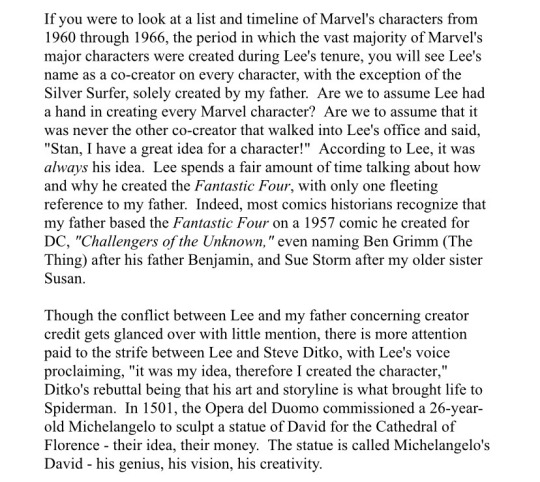
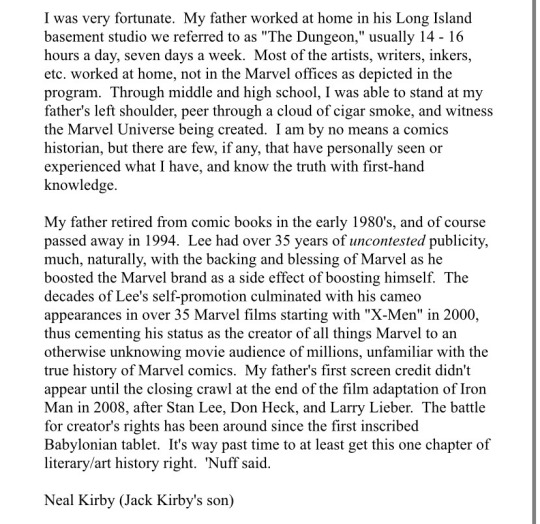
Statement by Neal Kirby on the recent Disney+ Stan Lee documentary.
Full transcript below:
The 13th-century Islamic poet/scholar Rumi said, "The Ego is a veil between humans and God." In the Disney+ documentary bio of Stan Lee, the veil is lifted. Presented in the first person with Lee's voice providing a running narrative, it is Stan Lee's greatest tribute to himself. The literary expression of ego is the personal pronoun "I." Any decent English or Journalism teacher would admonish their students not to overuse it. So, the challenge is extended to anyone who wishes to count the number of "I's" during the 86-minute running time of Stan Lee.
I (000ps!) understand that, as a "documentary about Stan Lee," most of the narrative is in his voice, literally and figuratively. It's not any big secret that there has always been controversy over the parts that were played in the creation and success of Marvel's characters. Stan Lee had the fortunate circumstance to have access to the corporate megaphone and media, and he used these to create his own mythos as to the creation of the Marvel character pantheon. He made himself the voice of Marvel. So, for several decades he was the "only" man standing, and blessed with a long life, the last man standing (my father died in 1994). It should also be noted and is generally accepted that Stan Lee had a limited knowledge of history, mythology, or science.
On the other hand, my father's knowledge of these subjects, to which I and many others can personally attest, was extensive. Einstein summed it up better; "More the knowledge, lesser the ego. Lesser the knowledge, more the ego."
If you were to look at a list and timeline of Marvel's characters from 1960 through 1966, the period in which the vast majority of Marvel's major characters were created during Lee's tenure, you will see Lee's name as a co-creator on every character, with the exception of the Silver Surfer, solely created by my father. Are we to assume Lee had a hand in creating every Marvel character? Are we to assume that the other co-creator never walked into Lee's office and said, "Stan, I have a great idea for a character!" According to Lee, it was always his idea. Lee spends a fair amount of time talking about how and why he created the Fantastic Four, with only one fleeting reference to my father. Indeed, most comics historians recognize that my father based the Fantastic Four on a 1957 comic he created for DC, "Challengers of the Unknown," even naming Ben Grimm (The Thing) after his father Benjamin, and Sue Storm after my older sister Susan.
Though the conflict between Lee and my father concerning creator credit gets glanced over with little mention, there is more attention paid to the strife between Lee and Steve Ditko, with Lee's voice proclaiming, "It was my idea, therefore I created the character," Ditko's rebuttal being that his art and storyline is what brought life to Spiderman. In 1501, the Opera del Duomo commissioned a 26-year-old Michelangelo to sculpt a statue of David for the Cathedral of Florence – their idea, their money. The statue is called Michelangelo's David – his genius, his vision, his creativity.
I was very fortunate. My father worked at home in his Long Island basement studio we referred to as "The Dungeon," usually 14 – 16 hours a day, seven days a week. Most of the artists, writers, inkers, etc. worked at home, not in the Marvel offices as depicted in the program. Through middle and high school, I was able to stand at my father's left shoulder, peer through a cloud of cigar smoke, and witness the Marvel Universe being created. I am by no means a comics historian, but there are few, if any, that have personally seen or experienced what I have, and know the truth with first-hand knowledge.
My father retired from comic books in the early 1980s and of course, passed away in 1994. Lee had over 35 years of uncontested publicity, much naturally, with the backing and blessing of Marvel as he boosted the Marvel brand as a side effect of boosting himself. The decades of Lee's self-promotion culminated with his cameo appearances in over 35 Marvel films starting with "X-Men" in 2000, thus cementing his status as the creator of all things Marvel to an otherwise unknowing movie audience of millions, unfamiliar with the true history of Marvel comics. My father's first screen credit didn't appear until the closing crawl at the end of the film adaptation of Iron Man in 2008, after Stan Lee, Don Heck, and Larry Lieber. The battle for creator's rights has been around since the first inscribed Babylonian tablet. It's way past time to at least get this one chapter of literary/art history right. 'Nuff said.
21 notes
·
View notes
Text

MWW Artwork of the Day (5/8/24) Michelangelo Buonarroti (Italian, 1475-1564) David (1501-04) Marble sculpture, 13 feet 6 in. (434 cm.) high Galleria della Academia di Belle Arte, Florence
The proportions of the David are atypical of Michelangelo's work; the figure has an unusually large head and hands (particularly apparent in the right hand). These enlargements may be due to the fact that the statue was originally intended to be placed on the cathedral roofline, where the important parts of the sculpture would necessarily be accentuated in order to be visible from below. It is possible that the David was conceived as a political statue before Michelangelo began to work on it. Certainly David the giant-killer had long been seen as a political figure in Florence.
3 notes
·
View notes
Text
Essay: Picture vs Painting

Johannes Vermeer. Girl Reading a Letter at an Open Window. c. 1657–1659.
For Francis Bacon, painting was “mysterious because the very substance of the paint, when used in this way (of idea and technique being inseparable), can make such a direct assault upon the nervous system; continuous because the medium is so fluid and subtle that every change that is made loses what is already there in the hope of making a fresh gain.���
Material is everything, the energy and emotions associated with the material all the more important. One of my teachers, Lorna Ferguson was so pleased with me getting paint on any and everything (much to my personal dislike at times as I valued some of the objects I had ruined to create something); for a while I could not understand the marvel, as I thought; ‘well, what other way is there to work with said substance.’ It never occurred to me, at least in the way of the artists mind, that painterly was being concerned with making the idea and technique of painting inseparable. I won’t speaking on being (an artist) - hard as it may be, but I’ve covered that in my previous article - but focus on the idea and the substance.
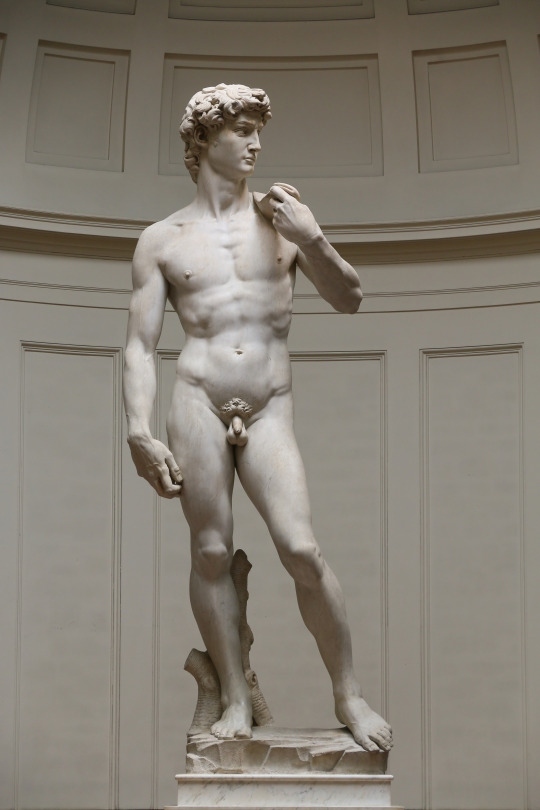
Michelangelo. David. c. 1501 – 1504.
Another one of my teachers, Ricky Burnett spoke of the ‘history of a painting’; which I interpreted as the realm of the invisible. I believe the object has to take up space in a way that it too exudes an energy, an idea that is made more complex when there are sentients in the space, it ultimately speaks to its power, of which is the result of its creator, involuntary or not. I have an issue when the objects is of nothingness, static and unimaginative. Minimalism is a great example of this, namely in the art of architecture, photography to painting itself. How can it be said that an object carries any sort of character if it is pristine, wherein it’s function has no interest in the material as forming part of its function and results in its being fixed and changeless. It is a result of such functionality, or rather, lack thereof that the object carries no sense of presence in that it becomes just another object in space disconnected from its surroundings, thus ultimately alienating itself from humanity.
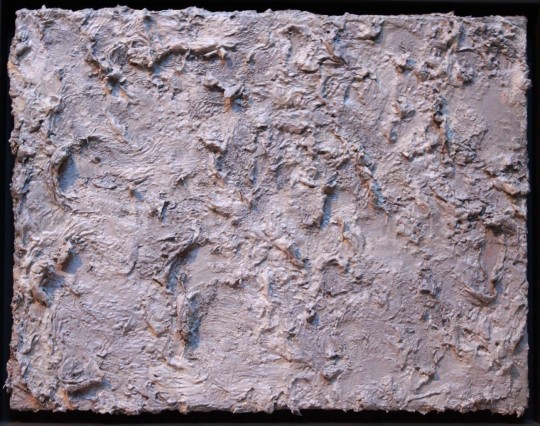
Ricky Burnett. Troubled with Goya 3.
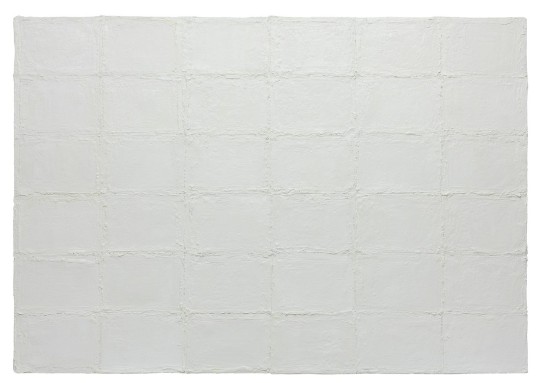
Ricky Burnett. High Windows 2.
The makings and process of the objects should in themselves be studied, understood and appreciated in their materiality, most importantly in a way that they take into account the service to humanity and its relationship with time, history and ultimately the heritage of mankind’s culture. I believe that with this approach, humanity serves the object too resulting in a relationship that is ultimately symbiotic. The concept of symbiosis is one some artists and a larger group of designers have let go of, it makes the work easier, quicker and at no real cost to produce as it cares not of what it is in service of or to whom and as a result of its innate purpose.
The realm of invisible is learning to make these connections, meaningful ones with all that is around us and we’ll begin to feel, most importantly, interpret in the way of our individual being. Because you see I believe that the process is reflected in life of the painting/object - take for instance a Vermeer who layered multiple layers on thin glazes of paint each carrying their unique emotional state of the artists or Michelangelo labouring for just over 3 years on his David sculpture). The lack of such connected process results in an art that does not appear to show signs of time or even care for it; objects lose identity as they disconnect themselves from their creator and, most importantly, the generations they are a result of, leading to a worthlessness to the object. Such worthlessness is dangerous because objects lose any sense of importance, as having nothing to say to anyone or reflect on anything, a disconnect that dismisses their desire to be preserved; this is how a people are erased from history. Minimalism is now a job for artificial intelligence, the insentient.
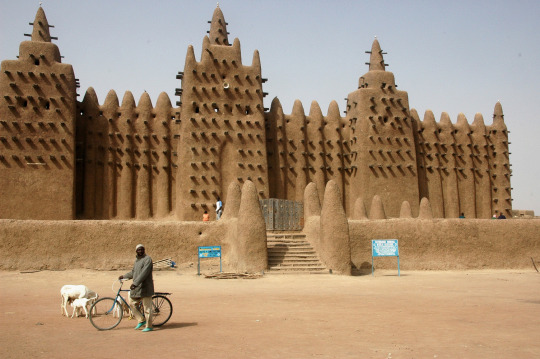
King Koi Konboro. Great Mosque of Djenné. Thirteenth century
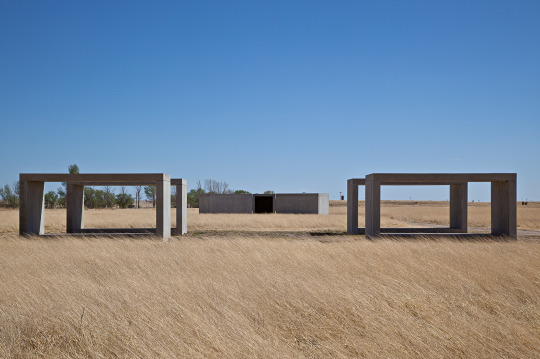
Donald Judd, 15 Untitled Works in Concrete, 1980-1984.

Sir Giles Gilbert Scott. K6 (Kiosk No. 6). 1935.

#painting#design#architecture#vermeer#michelangelo#david#sirgilesgilberscott#telephone#great mosque of djenne#rickyburnett#FrancisBacon
10 notes
·
View notes
Text
Torey Akers 23 March 2023:
"A school principal in Tallahassee, Florida, has been fired following parental complaints about a lesson on Michelangelo’s marble masterpiece David (1501-04), which was deemed “pornographic” by one aggrieved parent.
The now-former principal, Hope Carrasquilla, informed the Huffington Post that, due to a “series of miscommunications”, a customary letter informing parents of students at Tallahassee Classical School about this feature of the sixth-grade art history curriculum was not sent out, further contributing to parents’ outrage. One parent felt “point-blank upset”, Carrasquilla told HuffPost, and “felt her child should not be viewing” the iconic 16th-century exemplar of Renaissance sculpture, which depicts a figure from the Old Testament's Book of Samuel.
According to the Tallahassee Democrat, Tallahassee Classical School, a charter school in Florida's state capital, has now lost three principals since it opened in 2020. Carasquilla had worked there for less than a year. The school's “classical education curriculum model" is an increasingly popular pedagogical model in Florida that advocates a return to the foundational tenets of Western civilisation. The school is affiliated with Hillsdale College, a conservative Christian institution that has sought to “fight leftist academics” by expanding into charter school fundraising and implementation.
“Once in a while you get a parent who gets upset about Renaissance art,” Carrasquilla said.
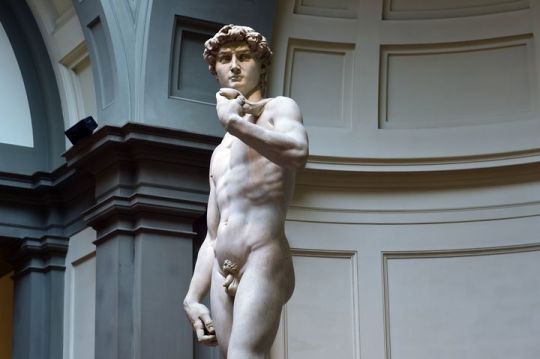
The move to oust Carrasquilla rides a cresting wave of conservative educational legislation in Florida and across the US. Florida governor Ron DeSantis, dubbed the “Education Governor” due to his efforts to transform the state’s school system, has targeted high school advanced placement studies in African American history as a form of “woke indoctrination”, signed a bill to ban transgender athletes from girl’s public school teams, banned more than 40% of math textbooks that publishers submit for review and passed the Parental Rights in Education Act, which prohibits any conversation about sexuality and gender in kindergarten and the first three grades of elementary school.
DeSantis also passed a bill that allows teachers to be armed at school and instituted the “Stop WOKE Act", aimed at preventing “discrimination in the workplace and public schools”. His targeting of tenure, affirmative action and diversity, equity and inclusion measures at the state's public universities reflects a nationwide Republican project to regulate and politicise education."
ffs.
These people are pathetic. Ignorant, barbaric, and highly dangerous.
And of course it's another thing the Simpson's predicted...

We've all got to fight back against the return of this dangerous censorship everywhere, including on tumblr.
4 notes
·
View notes
Text

Michelangelo Finishes David
We are in 1504 and Michelangelo has officially finished sculpting David. Michelangelo is a key artist of the Italian High Renaissance. Michelangelo di Lodovico Buonarroti Simoni born and raised in Tuscany, was trained in both painting and sculpting with a very special love of marble. Michelangelo began his creation by accepting the challenge of creating David from a single block of 17 feet tall white marble and a weight of 6 tons, This creation began in the year 1501 and finished in 1504. This sculpture was set to be placed in Cattedrale di Santa Maria del Fiore; however, the sculpture is nearly impossible to lift let alone move. Therefore, the sculpture will remain in Palazzo della Signoria and represent strength and defiance. The sculpture of David portrays a Biblical hero figure who was unarmored when he defeated and beheaded against all odds colossal Philistine Goliath. Besides using religious symbolism for his sculpture, Michelangelo was inspired by the Republic of Florence. The city-state Florence served as the perfect inspiration for Michelangelo due to the awareness of threats surrounding them, but the great courage they had, even if disadvantage(similar to what Biblical David represents.) This sculpture was officially begun in 1464 by Agostino di Duccio and later carried by Antonio Rossellino in 1475. unfortunately, both sculptures refused to continue due to the presence of too many imperfections that may be a threat to the sculpture's stability. After being neglected for 25 years Michelangelo at the age of 26 took on the challenge and finally completed the 17-foot white marble statue. Michelangelo completed the statue by using a chisel and mallets and being delicate throughout the process. Michelangelo’s David served us as the perfect representation of courage and unexpected strength because of the symbolism extracted from the Biblical scenery, the representation of the city-state Florence, and most importantly, the courage he took to finish a project of such a high magnitude at such a young age.
1 note
·
View note
Text

I posted 494 times in 2022
That's 339 more posts than 2021!
28 posts created (6%)
466 posts reblogged (94%)
Blogs I reblogged the most:
@asingularcanadian
@landwriter
@be-they-do-crimes
@teejaystumbles
@alibonbonn
I tagged 490 of my posts in 2022
Only 1% of my posts had no tags
#fanart - 152 posts
#the sandman - 62 posts
#dreamling - 58 posts
#hades game - 56 posts
#patrochilles - 41 posts
#tsoa - 39 posts
#movies - 27 posts
#morpheus - 27 posts
#hob gadling - 26 posts
#achilles - 21 posts
Longest Tag: 134 characters
#and after he leaves (cheeks tinged pink and 'forgetting' the box there) hob's coworkers tell him how dream had been coming in for days
My Top Posts in 2022:
#5
“You’ve grown old, Hob Gadling.”
Hob tensed at the all too familiar voice. A voice he’d never forget, despite the years that had passed since he’d last heard it. The melodic, rich voice that transfixed many, Hob being no exception. He swallowed as he turned, knowing the voice could hear it, could hear his heartbeat suddenly in his ears.
“Tends to happen to mortals, you know?” Hob regarded him in the darkness. He was a shadow on the wall, peeling away and floating towards him now.
Morpheus glides until he meets Hob at the window he’s stationed at. The night is cold and bitter, snow has begun to gently fall, like ash after a bonfire. After a public execution.
“Have you come back to me, my one?”
See the full post
254 notes - Posted November 8, 2022
#4
Robert Gadling is a character just BRIMMING with possibility. The lives he’s lived, the cultures he’s been a part of. The turning points in history that he’s witnessed! He’s into printing in 1489, imagine he was in Germany when Gutenberg invented the printing press? Why not! (He probably still owns a copy of Gutenberg’s Bible). Hob goes through an art phase and is there for the unveiling of Michelangelo’s David (imagine how fucking immaculate that statue looked in 1501). And then, Hob stays in Italy, obsessed with the renaissance and maybe befriending Michelangelo, gifted with the privilege to witness him working for 5 years on the ceiling of the Sistine Chapel in Rome. Hob’s life is rife with history, with experience. He’s traveled the world, I bet he joined Ferdinand Magellan’s expedition to circumnavigate the globe (because Hob would, HE WOULD). He lived on that ship and drank piss ale and rum and stepped on land he never dreamed of exploring.
Hob’s there for the steam engine. Can you imagine him ranting and raving to Dream about how they managed to remove water from flooded mines and convert it into energy? “The power of steam!” Hob raves, gesticulating at Dream with a huge grin on. The birth of rail transport, the invention of the telegraph, the suffrage movement “women are finally fighting back!” I’d love to read something where Hob gets smacked with an appreciation for women, because you know he must’ve been some kind of problematic womanizer, back in the day (century). On and on and on it goes!
He's lived dozens and dozens of lives, different names, shifting personalities. Everything you can think of, Hob’s done it. I love when fic writers just let their imaginations run wild with Hob, the deeper the introspection the better.
He strikes me as a man of adventure and consequence. He’s smart, so fucking smart. Imagine the schooling this man has had, imagine the life experience. Imagine the people he’s taken to his bed too. This man is a literal definition of “fuck around and find out.”
Imagine the loneliness at times, knowing each relationship never develops. He makes friends, lovers, and has to break their hearts. Hob probably starts accidentally falling in love with Dream because he’s his only constant in life. He probably bites his tongue every time they meet, wanting to beg for more than one visit a century. By the 1600s Hob’s desperate for companionship. He loves the gift of immortality freely given to him, he treasures every second on this green earth, but god damn can it get lonely.
I want to read Hob speaking foreign languages, communicating effortlessly and fluently with anyone. Striking up a conversation because someone catches him reading a worn copy of The Odyssey in its original ancient Greek or something like that. Can you imagine the tracks he has to switch in his brain when he has to converse in Yiddish? Turkish? Japanese? It probably takes him a full minute to rifle through his metaphorical filing cabinet, like a slow Internet connection because you have too many tabs open.
Imagine all the work he’s done, the jobs he’s taken up, good and bad. Morally gray or just immoral, so bad Hob can’t bear to remember. (He’s been in the mob, he’s been in a gang, he's been a marksman, he’s been a private investigator, he's been a doctor and an archeologist, on and on and ON). I can see him loving a position as a museum curator.
Oh man, this got long.
TL;DR: I go absolutely insane for a Hob character analysis that explores his time through history and how it has changed him as a person.
319 notes - Posted November 13, 2022
#3
Hob hums along to the music quietly playing through his phone speaker, the knife in his hand coming down swiftly over the thinly sliced peppers, dicing them for his latest meal endeavor. He’d never really been much of a cook, but after living on his own for so many years, Hob came to the realization that living off takeout and boxed pasta wasn’t very sustainable (or healthy) and had strived to make at least one homemade meal a day. And today it was breakfast.
He scraped the bell pepper into a small bowl and reached for the red onion. Hob was on a mission this morning to get an omelet correct– redemption round– he called it. Preparing the vegetables was easy enough, it was cooking them with the egg mixture while keeping its integrity that was the challenge.
With the knife poised to make the first cut into the onion, Hob suddenly feels two arms snake around his waist, followed by a cold nose pushing its way through his hair at the back of his neck.
Hob huffs a startled, but pleased laugh, as Dream nuzzles his way around, pressing feather soft kisses on his neck and up to his ear. He didn’t even hear Dream approach; he never hears Dream, like the man weighed nothing or just glided along the squeaky floorboards. Hob unconsciously tilts his head, stretching his neck out for Dream to have more access.
“You weren’t there when I awoke,” Dream rumbles, his voice impossibly low and rough from sleep.
Hob smiles. He still has the knife in his hand, but he’s lowered it to the cutting board, blade safely out of the way.
“I wanted to get started on breakfast,” he answers simply, trying desperately to not turn his head and meet Dream’s wandering lips. “And I made coffee.”
Dream presses his body along Hob’s, crowding him against the counter and ripping a surprised gasp from Hob, which turns into a soft groan as Dream nips his ear before dragging an open mouth down his neck. One of his hands is slipping underneath the hem of Hob’s shirt, rucking it up and fingers dancing across his stomach.
Hob’s eyes slip closed and he swallows hard.
“I’m holding a knife, love.”
He feels one of Dream’s hands move from his hip to lightly grip his elbow, fingers caressing down Hob’s arm and gently dislodging the knife from his hand. Hob chuckles softly, accepting his fate and allowing Dream to tie their fingers together, resting their hands on the countertop as he pushes himself forward again, so Dream’s front is flush against Hob’s backside.
Hob’s breath catches in his throat, feeling the distinct, hard outline of Dream’s arousal nudge against his ass as he shamelessly rolls his hips, pulling Hob impossibly closer as he does so. Hob brings his free hand around, winding it back and touching Dream’s middle, feeling skin. He tilts his head back against Dream’s shoulder, splaying his fingers and exploring down past Dream’s ribs to his hips, and lower…
Hob is almost breathless as he speaks, almost stammers as Dream bites his exposed neck.
“Why are you naked?”
“Why aren’t you?” Dream counters before getting both hands on Hob’s hips and spinning him around, shoving a gloriously firm, pale leg against Hob’s crotch and crushing Hob against the counter with renewed vigor.
Hob can only meet Dream’s mouth as it descends onto his, moaning as Dream’s tongue slides along his, hot and insistent. Hob crumbles at once, wrapping his arms around Dream’s shoulders and pulling so there’s no more space between them, no more air.
Hob cries out at a particularly hard thrust, causing his lower back to dig into the counter’s edge. Dream is kissing down his neck again and Hob can only hold on, getting a handful of silky soft hair and pulling.
“Dream–”
“Come back to bed,” Dream demands, licking the shell of Hob’s ear and making him shudder pleasantly.
Hob relents, abandoning his mission that was breakfast, it had been a lost cause from the start.
331 notes - Posted October 18, 2022
#2
had thoughts about Dream being able to sleep, how soft and human he would look. for your consideration:
Hob announced his arrival from work with a long sigh, heavy with exhaustion, and leaned into the door as he opened it and stepped into his flat. He dropped his keys in the little bowl and toed off his shoes. He had just shrugged off his messenger bag when he noticed a pair of large black boots in the living room, stark against his off-white rug. They were about a meter apart, like they’d been kicked off or tossed aside without a second thought.
With one brow raised, eyes scrupulous, Hob deposited his bag on the couch and bent down to pick up first one boot, then the other, tucking them together and neatly placing them on the wooden floor next to a bookshelf.
“Dream?” Hob called out, straightening up and casting his gaze upon the room. It wasn’t like Dream, when he paid surprise visits, to not immediately be within eyesight of the door, let alone leave his shoes haphazardly on the carpet.
Hob’s eyes landed on the entryway of the hall, spotting Dream’s thick, long coat in a heap on the center of the floor. Worry began to creep in as Hob slowly stepped up to Dream’s mystical coat, his pulse thrumming under his skin. He stooped down, grabbing it by the collar and brushing it off with his other hand. The material felt luxurious in Hob’s hands, soft like cashmere or shahtoosh, but also durable– something akin to wool or even canvas. Hob’s fingers caressed the fabric, feeling the lip of the tall collar between his thumb and fingers.
Gently folding the coat over one arm, Hob continued down the hall, stepping softly, carefully.
Hob’s bedroom door was open, the rays of the setting sun streamed in through the window and lit up the entryway, revealing more dark clothes in a jumble leading into the room.
Swallowing, lips parting, Hob bent down once more to collect Dream’s t-shirt, his pants and, following the line of mayhem, his socks, taking them all into his arms. Hob wasn’t sure what he expected to see when he finally straightened up and turned, but it certainly wasn’t this.
Hob almost dropped all the clothes he had spent carefully collecting, his mouth going dry.
There was a considerable, person-sized lump in Hob’s bed, buried under his thick gray comforter. The only indication that it was indeed Dream laying in Hob’s bed, was the mane of wild dark hair poking out from the mass of linens.
Hob took a step forward, then another, crushing the pile of clothes to his chest as he walked around the bed, his gaze transfixed to the top of Dream’s head– a smattering of black ink spilled on his white pillow. He held his breath as he finally came to face Dream, the only part of him sticking out was his nose and eyes, Dream’s impossibly long lashes draped down, threatening to brush the tops of his cheeks.
Hob felt his jaw drop, lips parting in wonder at this ethereal creature in his bed.
Dream was sleeping.
See the full post
565 notes - Posted October 28, 2022
My #1 post of 2022
You are an obsession, you're my obsession Who do you want me to be to make you sleep with me?
“Hello, Hob,” a low, sultry, and achingly familiar voice speaks behind him, cutting through the heavy bass reverberating off the walls and straight through Hob’s chest, lighting him up.
Turning, Hob finds– who he’d been referring to as– his stranger behind him, close enough to reach out and touch. They’re in the middle of the dance floor, bodies packed and grinding all night, but somehow they’ve given them room now.
Hob was dreaming, he was aware of it almost immediately. He’s been thrown back into the 1980s, one of Hob’s favorite periods of the 20th century, and in a nightclub no less. The music loud enough to penetrate skin, feeling the twangy synth pop in his bones. Everyone around him dressed in every color of the rainbow, over accessorized in neon hoop earrings and bangles, leg warmers, windbreakers, and mesh patterns.
Hob’s dreams often took him back in time, and he wondered what prompted this. Though as Hob often did in his dreams, instead of considering why, he simply indulged. The music wasn’t anything particular, perhaps nothing was actually playing and it was all in his head, but Hob had felt the push and pull of everyone around him and followed along like a buoy at sea.
And now, feeling drunk off the sticky sweet air in the room, Hob grins as he boldly steps into his stranger’s space and slips both arms around his middle, pulling so his skinny, pale, gorgeous friend is flush against him.
He’d been dancing with strangers all night, shadows with indeterminate faces, allowing them to trace patterns on his skin, grip his shoulders or tug on his shirt. Hob hadn’t been dancing or even hanging around loud bars or clubs in decades, maybe somewhere deep in his subconscious, he missed it. Missed the anonymity of it all, getting high off everyone else’s pleasure and succumbing to it. So it made sense, as Hob felt himself getting hot, his skin prickling, that his imagination would wander, drifting to his perfect stranger. The only constant in his life, and someone who frequented Hob’s dreams often, especially as their centennial meetings came around or passed.
Though this iteration of his friend appeared distinctly… solid. He was dressed in that long black coat and skinny jeans from their last meeting (where he’d apologized, apologized! And called Hob a friend), his black hair gently tousled as before.
Hob paid it no mind as his tongue finally became useful and spoke for him.
“Hello, stranger.” he tried his best to mimic his friend’s deep voice and giggled at himself, cataloging the twitch of amusement in his usual stony face.
“You were thinking about me.” He spoke again, choosing to not point out how Hob currently had his arms ensnared around him and swaying them back and forth. “In a place like this.”
See the full post
811 notes - Posted November 3, 2022
Get your Tumblr 2022 Year in Review →
#omg guys...#it is INSANE to me how many notes my silly little fics have gotten#ive written for many fandoms but breaking 100 notes has always been a pipe dream#the sandman (and dreamling) fandom has really been so wholesome and amazing#(as you can see. in 2 months it has almost completely taken over my blog)#ive been having a blast and only hope this train continues into 2023#y'all are so fucking cool a;akjhdfj thank you for accepting me lol#my 2022 tumblr year in review#year in review#tumblr2022
4 notes
·
View notes
Text
It is difficult to tackle the monument that is Michelangelo's David, 1501/1504, first of all because of its size 5.17 meters high (without the pedestal) carved from a single block of white Carrara marble that had been abandoned after the failure of other sculptors. However, technology allows this rather successful confrontation of marble and man, who here has an anatomy that satisfies Michelangelo 1475/1564

The adolescent sculpted by Michelangelo is a powerful athlete, "magnification of the virile nude"
Michelangelo chose to represent David before the fight, at the moment when he challenges the giant Goliath, preparing to throw, with his sling

(whose strap passes over his shoulder and along his back), the stone that will strike his enemy in the forehead.
His attitude, a nervous contrapposto (the weight of the body rests on a single leg and the line of the hips opposes that of the shoulders), betrays a "contained violence".


The relaxed pose recalls Antiquity and expresses the medieval concept of the affinities of the two sides of the body: the right side is closed and protected, the left side open and vulnerable.




The work, incarnation of the virtus fiorentina, symbol of the Florentine civic virtue highly prized by Strength. Michelangelo depicts an adolescent David, lanky, full of pride and the strength of his youth, but also a little hesitant and marked by his fierce side. The idealization of the head is accompanied by an astonishing anatomical accuracy.

Of this very handsome young man who posed for this reconstruction, the gloomy spirits found one fault, not being uncut!

3K notes
·
View notes